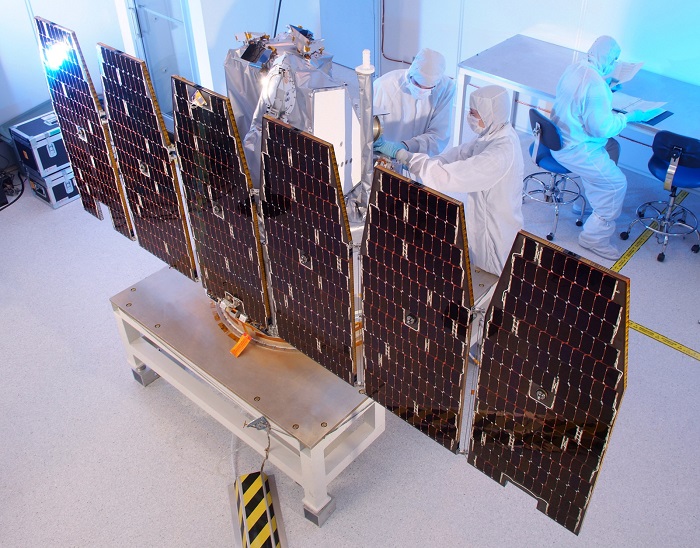By Maurizio Di Paolo Emilio, contributing writer
A satellite needs an energy source to provide perfect performance, with the battery inside it working continuously for many years. The electrical power system is, perhaps, the most fundamental requirement for the satellite payload, as power system failure results in the loss of the space mission. It’s interesting to note that many of the early satellite systems failed due to these power system failures.
Power systems cover all aspects of energy production, storage, conditioning, distribution, and conversion for all types of space applications. Missions can last from a few minutes (launchers) to decades, such as interplanetary probes or the International Space Station (ISS), and can require from a minimum of a few watts (cubes) to tens of kilowatts (large space vehicles for telecommunications such as for the ISS). The electrical loads of a satellite often vary depending on which instruments or subsystems are running at a given time.
Therefore, power systems engineering (also called the electrical power system, or EPS) for satellites requires the selection of the optimal combination of primary and secondary sources for the architecture.
Power sources
Power systems mainly consist of electrochemical sources — i.e., primary or secondary batteries — or a solar generator supported by a battery when the spacecraft enters an area with low solar coverage. Today, most satellites are based on advanced solar cells with an efficiency of about 30% and lithium-ion (Li-ion) batteries.
When the distance from the sun becomes too high, which is typically beyond Jupiter, the solar flux can no longer be used effectively, and nuclear sources are the only option left. The sun provides about 1.4 kilowatts of power per square meter in Earth’s orbit, a free resource that spacecraft designers do their best to take advantage of.
Today’s triple-junction solar cells used in these applications will be replaced by more efficient four- to six-junction solar cells in the coming years. New battery technologies, such as lithium-sulfur , are currently under intense efforts to provide a new step forward in energy density (Fig. 1 ).

Fig. 1: Solar cell on a satellite. (Image: NASA)
In a typical satellite-based power system, the primary system, in particular, is responsible for generating the main power bus. The most popular solutions include the use of solar panels, fuel cells, or in the case of short missions — such as launchers used to take satellites and probes into orbit — Li-ion batteries. On the other hand, in long-term missions and in conditions of low solar radiation intensity, systems for the electrical generation using the Seebeck effect have been adopted, which make use of the slow decay of radioactive materials.
The secondary power system is used to supply the power to the satellite when the primary system is not able to function or fully satisfy the energy demand required by the operating scenario. In the case of satellites with solar panels, for example, this happens during periods of an eclipse when the panels are not directly exposed to the sun or the inclination of the satellite reduces the incident radiation flow to the panel itself. The most common solution is undoubtedly the use of Li-ion batteries. In the case of equipment that requires high power, typically over 100 kW, regenerable fuel cells have also been used.
In the field of power electronics, the tendency is to reduce the size of the equipment while increasing the efficiency at the same time. Also, in this case, advanced components such as gallium nitride (GaN)- or silicon carbide (SiC)-based semiconductors are the subject of essential development efforts to achieve both objectives.
One of the most essential tasks of energy conditioning is, therefore, to optimally control the power exchanges between the solar generator, the battery, and the loads. This means ensuring that the power delivered to the loads remains within the voltage range that they can accept, sizing the solar array so that the battery can be recharged while the spacecraft equipment is powered.
Because the power system is the only resource for the spacecraft, it must be protected from failures that could degrade it or even put it out of service, especially in short-circuit situations.
Taking into consideration the satellites that use solar panels, the periods in which the primary source is not able to produce electricity (such as during eclipses) strongly depend on the type of orbit. Typically, the low Earth orbit (LEO) eclipses last only 35 minutes for each low-inclination orbit, while in the geostationary Earth orbit (GEO), eclipses occur only in the two equinox periods, with a maximum duration of 1.2 hours in 24 hours.
The main parameters that need to be considered for choosing the type of battery are useful life (in years), specific weight (kWh/kg), and volume (kWh/m3 ). Usually, the parameters that most influence the choice of battery type for satellites are the specific weight or the quantity of energy that can be stored according to its weight.
One of the critical aspects of batteries for space operation is the reliability and efficiency of the charge. The fundamental parameters, in this sense, are the battery charge/discharge speed, its depth of discharge, the amount of battery overcharge, and thermal sensitivity.
Visit EE Times to read the complete story.
Related articles:
Part 2: Thermal Control Systems for Spacecraft Demand Passive & Active Design Techniques
Advertisement
Learn more about Electronic Products Magazine





